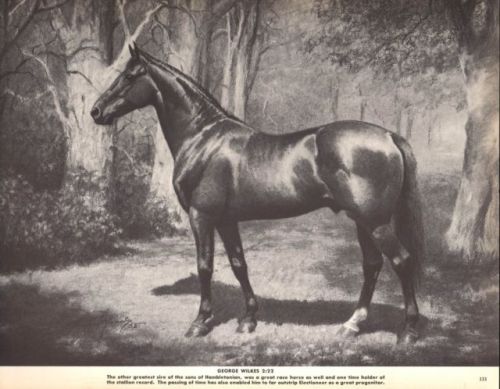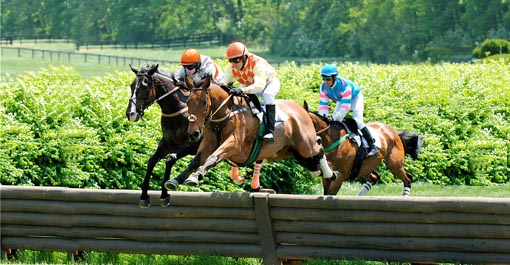Of course, when it comes to our equine interests, thoroughbreds aren’t the only horses that bring pleasure and profit to their owners. Several of the people in my family tree were well known for breeding, showing and racing trotters, saddlebreds and steeplechasers.
James Long was born in Scott County, Kentucky, in 1827. His father before him was born in Scott County, was a dealer in fine horses and bought what became the Carview farm in 1819, when it was wild land. James and his brother continued to live on the homeplace into adulthood, sharing management until James bought it. He divided the land between grazing and cultivation and was quite successful dealing in coach and carriage horses. In 1860, James married Susan Peak and thus became husband of my second cousin three times removed. Around 1870 he began the rearing of trotting horses from the famous sires Almont, Mambrino Patchen, and George Wilkes. He bred, reared and trained Katie Jackson who sold in 1878 for $6,300. He also reared Gracie Goodwin as well as a good number of trotters who sold young. The farm had a private three-quarter mile track for the development of trotters.
The Louisville Daily Courier carried this description of a horse exhibition at the Fair Grounds on June 8, 1866, in which James Long had entered a competition for best pair of coach horses, sixteen hands high:
This exhibition was splendid, and the performances seldom equaled in any ring. Shockeney’s dapple grays and Mr. Long’s horse were the favorites, though the other competitors were very superior horses. The driving in this ring was most excellent, and the horses in elegant condition, evincing not only skillful training but the finest qualities otherwise belonging to the horse. They were reined in and out, suddenly turned and put through the various evolutions of the ring with the most skillful precision and exactness, eliciting the highest applause and enthusiasm from the audience as the band played delightful music. Bouquets were showered in rich profusion from the amphitheater upon the drivers. The contest was very animated and protracted. The drivers stopped at length before the Judges’ stand, the horses showing considerably the effects of the beat. The premium [$50] was given to James Long, of Scott county . . . .
In 1887, Long announced in Kentucky Stock Farm that he would be letting Petoskey, son of George Wilkes, at stud for $50:
Petoskey is seven years old this spring, a deep blood bay, full 16 hands high, and weighs 1,350 pounds. He has a fine head and ear, fine style, with a deep shoulder, running back well with a strong back, fine round hips and buttock; ribs close to hips, very strong, heavy muscles, with extra good flat legs, and carried a very fine natural tail. Petoskey, with but little training, can trot and pace the two gaits combined faster than any stallion in the State.

George Wilkes, sire of Petoskey
Also a successful breeder and exhibitor of saddlebred horses was Robert Chester Tway, my fifth cousin twice removed. “R. C.” was born in Louisville in 1881 and became a prominent businessman, founding the Tway Coal Company, Tway Building Materials Company, Plainview Farms Dairy, and Kentucky [Trailer] Manufacturing Company. On his Plainview Farm, more than 50 horses were stalled under his direction. Tway was most famous for his ownership of Plainview’s Julia, the 1959 and 1960 World’s Grand Champion Five-gaited American Saddlebred and Plainview’s Sophia Van Cleve, the 1960 World’s Reserve Champion Three-Year-old Five-gaited American Saddlebred. He was a former director of the National Saddle Horse Breeders Association.

Plainview’s Julia
Interestingly, I had heard about R. C. Tway from my mother before I ever realized we were related. As I told you, my mother was orphaned at a young age and lived in the Methodist Home for Widows and Orphans. R. C. Tway was on the Board of the Home and saw that my mother got her first teaching job after graduating from the University of Kentucky — in a one-room school house for the Tway Coal Camp in Harlan, Kentucky. It was only earlier this year, and several years after Mother’s death, that I discovered that she and he were actually fifth cousins once removed. Mr. Tway died in 1964.
James Young Pennebaker, my fourth cousin once removed, lived most of his life in the Washington, D.C. area but had strong ties to Kentucky. His parents, Lulie Harris and Charles Darwin Pennebaker, were born in Louisville. Charles Darwin’s family moved to Washington, D.C. when he was a boy but the family, and his later family, were always referred to as being “of Georgetown, D.C. and Kentucky.” Their son James Pennebaker was born in Washington, D.C. He enlisted in the French Army Ambulance Corps in 1916 and when the U.S. entered World War I, he served in the U.S. Army. He worked in New York City briefly in the investment business, then returned to Washington, married in 1924 and worked for a real estate firm before concentrating on his own real estate investments and mortgage banking. When he died in 1981 at the age of 84, his obituary said, “He never retired.” James was a horseman and member of the Virginia Thoroughbred Association. He raised and trained hunters and steeplechasers, including Derrydown, who was successful in steeplechase races in the 1960s and the early 1970s.

Steeplechasing in Virginia
Interestingly, Charles Darwin Pennebaker and Lulie Harris were my great-grandparents. I found your page on a search for Col. Charles Darwin Pennebaker, his father, who attended West Point and joined the Union Army. His portrait hangs on my wall and I was looking for more information about his career.
LikeLike
I am related through Lulie’s maternal line. Good luck with your research.
LikeLike